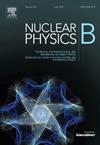Physical interpretations of integration constants and large gauge effects in flat and AdS spacetimes
IF 2.8
3区 物理与天体物理
Q2 PHYSICS, PARTICLES & FIELDS
引用次数: 0
Abstract
As in other partial differential equations, one ends up with some arbitrary constants or arbitrary functions when one integrates Einstein's equations, or more generally field equations of any other gravity. Interpretation of these arbitrary constants and functions as some physical quantities that can in principle be measured is a non-trivial matter. Concentrating on the case of constants, one usually identifies them as conserved mass, momentum, angular momentum, center of mass, or some other hairs of the solution. This can be done via the Arnowitt-Deser-Misner (ADM)-type construction based on pure geometry, and the solution is typically a black hole. Hence, one talks about the black hole mass and angular momentum etc. Here we show that there are several misunderstandings: First of all, the physical interpretation of the constants of a given geometry depends not only on pure geometry, i.e. the metric, but also on the theory under consideration. This becomes quite important, especially when there is a cosmological constant. Secondly, one usually assigns the maximally symmetric spacetime, say the flat or the (anti)-de Sitter spacetime, to have zero mass and angular momentum, and linear momentum. This declares the maximally symmetric spacetime to be the vacuum of the theory, but such an assignment depends on the coordinates in the ADM-type constructions and their extensions: in fact, one can introduce large gauge transformations (new coordinates) which map, say, the flat spacetime to flat spacetime but the resultant flat spacetime can have a nontrivial mass and angular momentum, if the new coordinates are such that the metric components do not decay properly. These issues, which are often overlooked, will be examined in detail, and a resolution, via the use of a divergence-free rank -tensor, will be shown for the case of anti-de Sitter spacetimes.
平坦和AdS时空中积分常数和大规范效应的物理解释
就像在其他偏微分方程中一样,当你积分爱因斯坦方程时,你会得到一些任意的常数或任意的函数,或者更普遍的其他引力的场方程。将这些任意常数和函数解释为原则上可以测量的物理量是一件非常重要的事情。集中在常数的情况下,人们通常将它们识别为守恒质量、动量、角动量、质心或溶液的其他一些细微之处。这可以通过基于纯几何的Arnowitt-Deser-Misner (ADM)型结构来实现,解决方案通常是黑洞。因此,人们谈论黑洞的质量和角动量等。首先,给定几何的常数的物理解释不仅取决于纯几何,即度规,而且取决于所考虑的理论。这一点非常重要,尤其是当存在一个宇宙常数的时候。其次,人们通常赋予最大对称时空,比如平坦时空或(反)德西特时空,质量、角动量和线性动量为零。这宣布最大对称时空是理论的真空,但这样的分配取决于adm型结构及其扩展中的坐标:事实上,人们可以引入大规范变换(新坐标),它将平坦时空映射到平坦时空,但如果新坐标使得度规分量不正确衰减,那么由此产生的平坦时空可以具有非平凡的质量和角动量。这些经常被忽视的问题将被详细研究,并通过使用无散度秩(0,4)张量来解决反德西特时空的情况。
本文章由计算机程序翻译,如有差异,请以英文原文为准。
求助全文
约1分钟内获得全文
求助全文
来源期刊

Nuclear Physics B
物理-物理:粒子与场物理
CiteScore
5.50
自引率
7.10%
发文量
302
审稿时长
1 months
期刊介绍:
Nuclear Physics B focuses on the domain of high energy physics, quantum field theory, statistical systems, and mathematical physics, and includes four main sections: high energy physics - phenomenology, high energy physics - theory, high energy physics - experiment, and quantum field theory, statistical systems, and mathematical physics. The emphasis is on original research papers (Frontiers Articles or Full Length Articles), but Review Articles are also welcome.
 求助内容:
求助内容: 应助结果提醒方式:
应助结果提醒方式:


